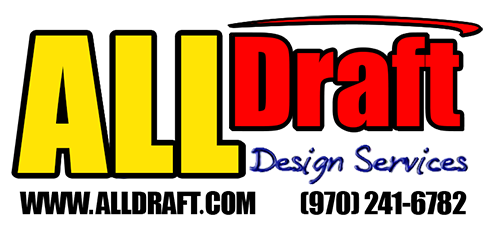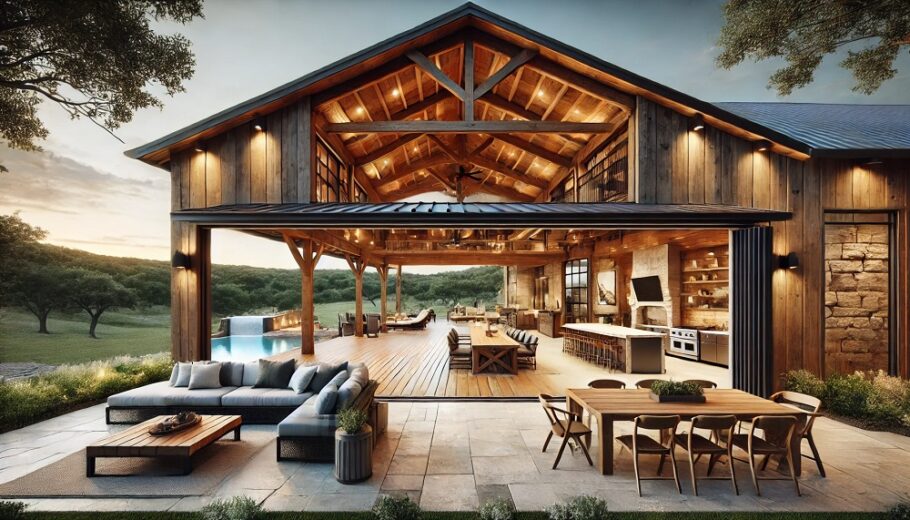Barndominiums are beloved for their open plans, tall clear-spans, and barnlike simplicity — but that simplicity can hide a complex challenge: how to route the HVAC ductwork, plumbing, and associated mechanical systems without turning the interior into a spaghetti bowl of services. A carefully engineered chase space (or chase system) keeps the building tidy, serviceable, energy-efficient, and compliant with code. This post walks through the practical engineering considerations, layout strategies, materials, acoustic and fire issues, and serviceability tips you’ll want to use when designing chase spaces for barndominiums.
What is a chase and why it matters in a barndominium
A chase is an enclosed, accessible pathway created in the structure to carry mechanical, plumbing, electrical, and other building services between levels or through partitions. In barndominiums — where metal frames, open trusses, and large roof spans are common — chases let designers:
- Keep ducts, pipes, and wiring hidden from view while preserving clear interior space.
- Group services together for shorter runs, better efficiency, and easier maintenance.
- Provide firestopping, insulation, and acoustic separation where required.
- Make future upgrades and repairs significantly easier and less destructive.
Because a barndominium often combines an open shop/garage area with conditioned living space, chase design must carefully manage transitions between conditioned/unconditioned zones, condensation risks, and penetrations through fire separations.
Chase types that work well in barndominiums
- Perimeter chases (wall chases)
Built within non-loadbearing interior partitions or the intersection of exterior walls and interior finishes. Good for vertical runs (supply/return risers, domestic water risers). They keep services out of the clear-span interior but can eat wall width. - Interior mechanical rooms / mechanical shafts
A dedicated room or shaft placed strategically (often near kitchen/bath clusters) that houses the furnace/air handler, water heater, and main plumbing/manifold. Excellent for centralizing equipment, but requires floor area. - Ceiling/floor plenum chases
Using the space between the roof/ceiling assembly or between a subfloor and finished floor. Suspended ceiling plenums can carry ducts and pipes — but in barndominiums roof heights are tall, so design for condensation control and insulation. - Overhead ridge or attic chases
For clear-span areas, an overhead chase built into an attic or above a loft can route long runs, but can increase duct lengths and thermal losses if unconditioned. - Exterior skirt/soffit chases
Useful for keeping large mechanical runs outside the conditioned envelope (easier maintenance access), but they must be well insulated when carrying conditioned air or hot water to limit losses.
Sizing chases — rules of thumb and practical guidance
Chase sizing depends on what you plan to run through it. Some practical starting points:
- Small plumbing and electrical riser (domestic cold/hot water, vent stack, electrical): minimum chase width ~6–8 inches — but this is really the absolute minimum; prefer 12 inches to allow for future changes and insulation.
- HVAC supply/return trunk with a few branches: 18–24 inches wide and 12–18 inches deep for modest systems; larger sheet-metal trunks (14″ x 8″ and larger) need proportionally larger chases.
- Combined mechanical + plumbing riser (stacking domestic hot/cold, DWV, condenser lines): 18–30 inches wide is common.
- Dedicated mechanical shaft with equipment access: plan for a 3′ x 3′ minimum clear working space in front of serviceable equipment; many designs allocate 4′ x 6′ or larger for air handlers.
Important: do not squeeze equipment into an inaccessible gap. A chase that’s technically “fits” your ducts but prevents a technician from opening panels, replacing filters, or pulling a length of pipe is a false economy.
Layout strategies: minimize length, simplify routing
- Centralize wet rooms — stack bathrooms, kitchens, and laundry vertically so DWV and water risers are short and efficient.
- Cluster HVAC zones — locate the air handler/ furnace centrally to reduce duct trunk length and balance static pressure.
- Run drains with slope — maintain a minimum slope (usually 1/4″ per foot for horizontal soil/waste lines) for gravity drains. Avoid long horizontal runs in chases whenever possible.
- Separate supply and return trunks — give each trunk sufficient cross-sectional area and avoid tight S-turns that increase static pressure.
- Plan condensate routes carefully — condensate must never connect to sanitary without an air gap. Provide a clear, trapped condensate drain with appropriate slope to a floor drain or condensate pump.
Material choices and detailing
- Ductwork: sheet metal (galvanized) is best for trunk lines — durable, low leakage, and easier to seal. Use flex duct for short branch runs only; avoid long lengths of flex in chases as it reduces airflow and traps moisture/dust.
- Plumbing: PEX for hot/cold water risers is flexible, requires less space than copper, and can be manifolded for shorter runs. PVC/ABS commonly used for DWV. Where penetrations cross fire separations, use fire-rated sleeves and firestopping compatible with the pipe material.
- Insulation: well-insulate ducts in chases that are outside conditioned space; use closed-cell insulation on refrigerant lines where condensation is a risk. Insulate hot water lines to reduce standby losses.
- Access panels: provide removable panels at equipment, at changes in direction, at cleanouts for drains, and at damper locations.
Fire, smoke, and acoustic requirements
- Firestopping: chases are continuous vertical or horizontal cavities that can transmit smoke and flame between floors. Any penetration of a fire-rated assembly must be properly firestopped using approved materials and techniques. Use fire-rated access doors where the chase passes through fire separations.
- Compartmentalization: where the chase connects conditioned/unconditioned zones, provide thermal and air barriers (vapour control) to prevent condensation and energy loss.
- Acoustics: mechanical noise can carry through chases. Use resilient mounts, acoustic liners in ducts, and offset penetrations so that pipes and vents don’t create direct transmission paths into bedrooms or living spaces.
Moisture and condensation control
- Place ducts for cooled air inside the conditioned envelope where possible. If chases pass through unconditioned attic space, insulate the ducts to prevent condensation.
- Refrigerant and condensate lines must be sloped and drainable. Provide accessible condensate traps and overflow protection that trips equipment off if the condensate pan overflows.
- Avoid routing domestic hot water uninsulated through cold chases — this raises heat loss and can create condensation on nearby cold surfaces.
Access, maintainability, and code considerations
- Service clearances: maintain manufacturer-recommended clearances to service equipment (furnaces, air handlers, water heaters). Provide removable access panels sized for replacement of common parts (filters, blowers, pumps).
- Drain cleanouts: include cleanouts at changes of direction and at the base of vertical DWV stacks inside the chase.
- Separation of systems: avoid running sanitary waste and potable water in the same small chase where they can’t be separated by proper wall thickness and backflow prevention devices. Do not route low-voltage cabling in the same conduit with unsheathed electrical service per code practices.
- Local code: codes vary — e.g., permitted materials, minimum sizes for shafts passing through floors, fire rating requirements, and required access door sizes. Always confirm requirements with the local building code and AHJ (authority having jurisdiction).
Coordination: catch problems on paper, not in the field
Chase design requires coordination between structural, mechanical, plumbing, and electrical disciplines:
- Clash detection: in CAD or BIM, run clash detection between trusses, rafters, posts, and the planned chases. Barndominium truss geometry often limits available vertical space.
- Structural penetrations: any penetration through primary framing members must be engineered. Prefer routing chases in non-structural walls or within framed openings intentionally sized to receive them.
- Equipment replacement: ensure the chase has an opening large enough to remove and replace large components like air handlers. If not possible, select compact equipment or plan for external equipment access.
Retrofit vs new build — different priorities
- New construction: take advantage of the chance to centralize and conceal systems. Frame dedicated shafts, pre-run conduit/PEX manifolds, and locate the air handler within the envelope.
- Retrofit/Conversions (shop→living): you’ll often be constrained by existing structure. Surface chases, soffits, and exposed but boxed-in ducts are practical. Prioritize condensate handling and insulating any newly routed conditioned lines.
Example chase layout (conceptual)
- Place a mechanical room adjacent to a stacked bathroom bank so DWV stacks remain short.
- Run the main supply trunk across the ridge in an insulated overhead chase; branch flex ducts into ceiling plenums for individual zones.
- Place domestic hot/cold PEX manifolds in a service closet near the mechanical room for short branch runs.
- Run condenser/refrigerant lines down a dedicated exterior chase to the outdoor condensing unit, with insulated line sets and a service panel at the chase top for access.
Checklist for engineers and designers
- ☐ Identify central location for HVAC equipment and plumbing manifold.
- ☐ Size chases for current systems + future expansion (add ~20–30% spare width).
- ☐ Provide required access panels and working clearances.
- ☐ Insulate ducts/lines passing through unconditioned chases.
- ☐ Include firestopping details for all penetrations and continuous chases.
- ☐ Provide required slopes and cleanouts for DWV and condensate piping.
- ☐ Coordinate with structural drawings to avoid compromising primary members.
- ☐ Specify acoustic isolation for noisy mechanical items.
- ☐ Ensure separation between potable water and sanitary or condensate disposal systems (air gaps/backflow prevention).
- ☐ Verify with local code and AHJ; document compliance in the drawings.
Final thoughts: design for the long term
A well-designed chase is invisible to occupants but invaluable to homeowners and service technicians. In a barndominium, where space expression and clear spans are key design features, chases let you preserve the architecture while keeping the mechanical heart of the building accessible, energy-efficient, and safe. Prioritize centralization, access, fire protection, and condensation control. When in doubt, size the chase a little larger than the immediate need — it’s cheaper to build extra space now than to cut new holes through finished metal siding or trusses later.

